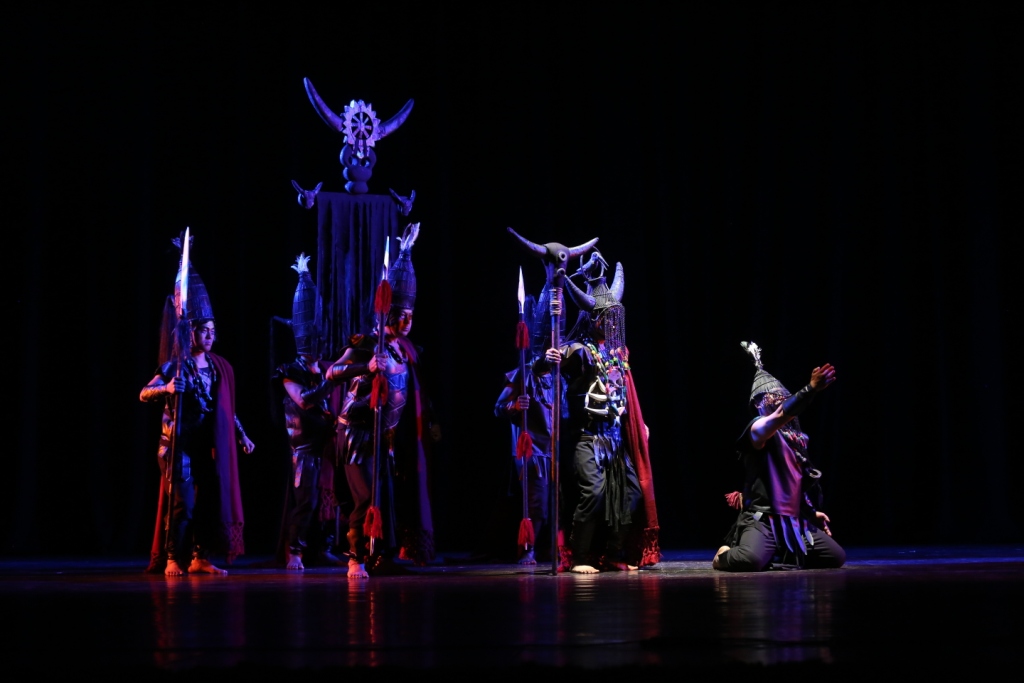By Onkareshwar Pandey
On July 23, 2025, the world of theatre dimmed as Ratan Thiyam, the visionary playwright, director, and cultural luminary, took his final bow at the age of 77 in Imphal’s RIMS Hospital. His passing marks the end of an era, not just for Indian theatre but for the global stage, where his work transcended borders, languages, and cultures to speak to the universal human spirit. To call him a theatre artist or director is to undersell the magnitude of his genius; I would say, he was a *Theatre Scientist*—a master alchemist who fused the ancient with the contemporary, the local with the universal, and the spiritual with the political. His stage was a laboratory where Manipuri traditions, global aesthetics, and the raw pulse of human experience were distilled into works of unparalleled beauty and truth.
A Life Dedicated to the Stage
Born on January 20, 1948, in Imphal, Manipur, Ratan Thiyam was a polymath whose creative journey began in painting and writing before finding its ultimate expression in theatre.
A graduate of the National School of Drama (NSD) in 1974, he founded the Chorus Repertory Theatre in 1976 on the outskirts of Imphal, creating a sanctuary where Manipur’s syncretic culture could dialogue with the world.

His theatre productions were not mere plays but profound meditations on war, identity, and humanity’s eternal quest for meaning._
Ratan Thiyam’s Mahabharata trilogy—Urubhangam (1981), Chakravyuha (1984), and Karnabharam (1989)—along with works like Uttar Priyadarshi and Lairembigee Eshei, were profound meditations on war, identity, and humanity’s eternal quest for meaning.
The trilogy, rooted in Bhasa’s Sanskrit classics and Thiyam’s original Chakravyuha, symbolically portrays an individual’s struggle against structured violence and their inevitable surrender to it. Urubhangam depicted Duryodhana’s shattered body and spirit, Chakravyuha captured Abhimanyu’s tragic entrapment with visceral choreography, and Karnabharam explored Karna’s existential crisis amid cosmic conflict.
As critic Samik Bandyopadhyay noted, quoted by Dr. Pinak Sankar Bhattacharya, Assistant Professor of English at Baneswar Sarathibala Mahavidyalaya, “Beginning with Bhasa’s Urubhangam in 1981, following it up in 1984 with his own Chakravyuha, and culminating with Bhasa’s Karnabharam in 1989, Ratan completed a Mahabharata trilogy, linked thematically by the central presence of an individual facing an onslaught of violence, a kind of cosmic, global flow of violence, that compels him to question his identity.”
Thiyam’s 2014 Macbeth, reimagined in a Meitei context with Manipuri music and Thang-Ta, transformed Shakespeare’s tragedy into a universal yet distinctly local exploration of ambition and ruin.
In India, Thiyam’s theatre stood alone, blending Manipuri traditions with modern sensibilities in ways unmatched by peers like Badal Sircar’s urban realism or Habib Tanvir’s folk experiments.
Globally, his ritualistic intensity drew parallels with Jerzy Grotowski’s spiritual minimalism, Peter Brook’s intercultural scope, and Tadashi Suzuki’s physical precision, yet his work remained uniquely rooted in Manipur’s syncretic culture.
His productions, like When We Dead Awaken at Norway’s Ibsen Festival, stunned global audiences with their surreal universality.
_Thiyam’s stage was a crucible where Manipuri aesthetics met the world’s theatrical traditions, cementing his legacy as a visionary without equal._
His work was a bridge between the ancient Natya Sastra, the Manipuri martial art of Thang-Ta, and global theatrical forms like Japanese Noh and Greek tragedy, earning him comparisons to titans like Jerzy Grotowski and Peter Brook.
Thiyam’s theatre was a rebellion against the colonial hangover that sought to erase India’s indigenous roots._
As a leading figure in the “Theatre of Roots” movement, alongside luminaries like BV Karanth and KN Panniker, he reclaimed Manipuri traditions—its dances, music, and storytelling—and wove them into narratives that challenged power structures and societal norms. His adaptation of Jean Anouilh’s Antigone as Lengshonnei critiqued political failures in Manipur, while his Macbeth (2014), set in a Meitei context, revealed the timelessness of human ambition and tragedy.
His plays were a mirror to Manipur’s turbulent socio-political landscape, reflecting the pain of ethnic strife, insurgencies, and the scars of war. As he once said, “War affects children. War affects women; it makes prostitutes out of them. All this is not normal.” His was a war on war, fought with the weapons of art, empathy, and relentless creativity.
Global Parallels: A Theatre Without Borders
Ratan Thiyam’s work was a tapestry of global influences, yet distinctly rooted in Manipur’s soil. Critics placed him in the same league as Grotowski, whose minimalist, ritualistic theatre sought spiritual transcendence, and Brook, whose intercultural experiments redefined modern performance.
Like Grotowski, Thiyam stripped theatre to its emotional and spiritual core, using disciplined choreography and haunting choral music to evoke primal truths.
Like Brook, he drew from diverse traditions—Natya Sastra, Noh, Kabuki, and Greek drama—to create a theatrical language that spoke to audiences worldwide, from Oslo’s Ibsen Festival to Seoul’s Theatre Olympiad.
His When We Dead Awaken (2010), a Manipuri interpretation of Ibsen, stunned Norwegian audiences with its surreal aesthetics and choral intensity, proving that Thiyam’s vision could resonate in any cultural context.
Thiyam’s ability to blend the local and the universal paralleled the work of Japan’s Tadashi Suzuki, whose Suzuki Method emphasized physicality and cultural memory, much like Thiyam’s use of Thang-Ta and Meitei rituals. His visually spectacular productions, described as “lyrical and surreal,” echoed the operatic grandeur of Ariane Mnouchkine’s Théâtre du Soleil, where myth and history collide in vibrant spectacle.
Yet, Thiyam remained uniquely himself—a son of Manipur who carried its stories, struggles, and syncretic beauty to the world stage. As he said, “Manipur is beautiful because of its syncretic culture… This is an outlook we inherited from our ancestors and this is precisely what has made our arts great.”
Voices of Admiration: Quotes That Capture His Genius
Thiyam’s impact was felt not only in his productions but in the words of those who witnessed his art. Former Manipur Chief Minister N. Biren Singh mourned his passing, saying, “His unwavering dedication to his craft, his vision, and his love for Manipuri culture enriched not only the world of theatre but also our very identity.”
Theatre scholar and critic Samik Bandyopadhyay likened Thiyam to “a poet of the stage,” noting his ability to “infuse rationalized and multifaceted analysis of myriad perspectives” into his plays.
Actor Rohini Hattangadi, Thiyam’s NSD classmate, remembered him as “studious, curious, and always experimenting with sounds and movements,” a testament to his relentless innovation.
Internationally, Thiyam was hailed as “India’s most internationally recognized director” by The Oxford Companion to Theatre and Performance, celebrated for his “visually spectacular productions that reflect the state of global [culture].”
Posts on X echoed this reverence, with users calling him a “doyen of Manipuri theatre” and a “visionary icon” whose work “brought modernity to performance.”
His final play, Lairembigee Eshei, performed in Delhi on February 17, 2025, was described as a haunting reflection on ecological apocalypse, a fitting culmination of his lifelong concern for humanity’s future.
A Roaring Legacy
When Thiyam was alive and roaring, the media celebrated him as a revolutionary. The Hindu (2018) described him as a “celebrated theatre director and poet” whose work grappled with the “dark times” of modernity, from digital isolation to global violence. The Indian Express (2020) lauded his role in the Theatre of Roots movement, noting how his plays challenged colonial stereotypes and reasserted Indian identity through Manipuri aesthetics. India Today (2018) quoted Thiyam’s belief that “diverse art practices teach us how to be human and show our place in this universe,” a philosophy evident in his productions at the 8th Theatre Olympics. His awards—Sangeet Natak Akademi Award (1987), Padma Shri (1989), Kalidas Samman (1997), Sangeet Natak Akademi Fellowship (2012), and Manipur’s Lifetime Achievement Award (2025)—were but modest affirmations of a legacy that defied quantification.
Preserving the Legacy of a Theatre Scientist
Ratan Thiyam’s departure leaves a void, but his legacy must not fade. His Chorus Repertory Theatre, a cultural beacon in Imphal, should be supported as a living archive of his work, training future artists in his interdisciplinary approach.
As Thiyam himself advocated in January 2025 at the Ningtham Khumhei Shumang Leela Festival, a world-class cultural complex in Manipur is essential to nurture the state’s artistic heritage.
His scripts, recordings, and production notes should be digitized and made accessible to scholars and practitioners worldwide, ensuring that works like Chakravyuha and Uttar Priyadarshi continue to inspire.
Educational institutions, particularly NSD, where Thiyam served as director (1987–88) and chairperson (2013–17), must integrate his methodologies into their curricula, emphasizing the fusion of traditional and contemporary forms. Festivals like Bharat Rang Mahotsav, where Thiyam’s plays were celebrated, should dedicate retrospectives to his oeuvre, showcasing his ability to speak to both local and global audiences.
Moreover, his call for unity through cultural expression—“Unity can only be achieved through the essence of oneness in diverse cultural expressions”—must guide efforts to bridge Manipur’s ethnic divides through art.
A Final Curtain Call
Ratan Thiyam was not just a theatre maker; he was a philosopher, a rebel, a dreamer who saw theatre as a force for social change and spiritual awakening.
His stage was a sacred space where Manipur’s stories—its pain, its beauty, its resilience—found a voice that echoed across continents. As he once lamented, “The digital age has made sure the past does not matter,” yet his work stands as a defiant testament to the enduring power of cultural memory.
To lose Thiyam is to lose a guiding star, but his light will shine on in every artist he inspired, every audience he moved, and every stage that dares to dream as boldly as he did.
Rest in peace, Oja Padma Shri Ratan Thiyam. Your theatre was a revolution, your science a revelation, and your legacy an eternal flame. As one X user poignantly wrote, “Heroes get remembered, but legends never die. He will be in our heart forever.”
Author Bio:
Onkareshwar Pandey is a Delhi-based journalist, author, and media strategist with over three decades of experience in print, television, and digital platforms. He is the Founder-Chairman of Golden Signatures Research & Consulting and serves as an Executive Fellow at Woxsen University. A passionate advocate for the arts, Pandey began his career as a theatre artist and critic in the 1990s and had the rare opportunity to witness Ratan Thiyam’s Mahabharata trilogy live at the Guwahati Festival. His deep engagement with culture, policy, and media has earned him recognition across academia and civil society.
Twitter: @Editoronkar | FACEBOOK: https://www.facebook.com/onkareshwar.pandey.1 | LINKEDIN: https://www.linkedin.com/in/onkareshwarpandey/



